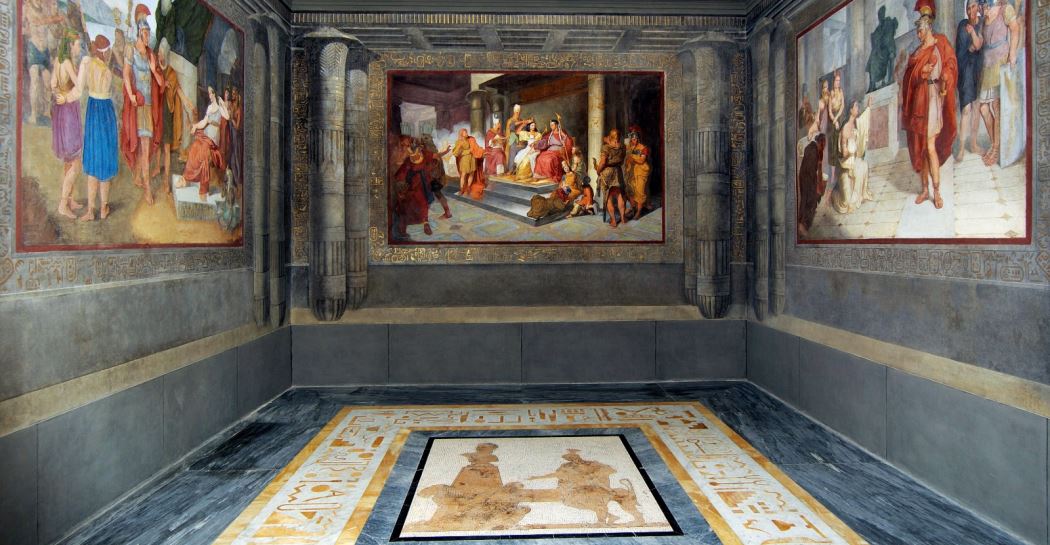Online museum
Special appointments to visit the museum from home and learn more about its history and heritage. These are virtual tours and video stories with audio and images to explain the museum and its masterpieces.

INTRODUCTION VIDEO
There are two historic buildings in Villa Torlonia that are used as museums: the nineteenth-century Casino Nobile, which houses the Villa Museum and the collection of works by the Roman School, and the Casina delle Civette Museum, dedicated to stained glass. The Casino dei Principi houses the Archivio della Scuola Romana and hosts temporary exhibitions.
Between history, nature and suggestions of the past, the Serra Moresca complex has been restored and is now open to the public. With its shining polychrome glass windows and elegant peperino, iron and cast iron structure, the Serra is unique in early 19th century Rome and still evokes the atmosphere that welcomed Prince Torlonia's guests. Immerse yourself in the marvellous architecture inspired by the Alhambra in Granada, to admire the fascinating play of light, the artificial cave, the small lakes and the collection of exotic plants!
La Serra Moresca di Villa Torlonia
VIRTUAL TOUR
The virtual tour of the Musei di Villa Torlonia/Casino Nobile, accessible from all devices, offers a journey to discover the beauty of the heritage through a digital experience that crosses the space limits of almost the whole museum space. Thanks to special controls, it is possible to move virtually around the museum, read the information panels on the rooms and works, zoom and turn images 360°, browse through photo galleries and videos and enjoy other background content. The "Don't miss" section, which contains a practical visual list of selected works or rooms, is a useful tool for those who are not familiar with the museum and are visiting it for the first time: by clicking on a room, for example "Sala di Bacco", the user is virtually transported between the walls frescoed with the Stories of the myth of Bacchus, the Seasons and the Three Continents. The tour is also enriched by intelligent maps that follow the visitor as he passes from one room to another, indicating rooms or works not yet displayed. Finally, thanks to the latest generation of drones, it is possible to take flight and see the rooms and works from above, enjoying an additional and unprecedented perspective on the visit.

PHONE CONVERSATION WITH GIULIA MAFAI
Giulia Mafai is interviewed by Antonia Rita Arconti, Manager of the Roman School Museum and Archives. A special guest for a long-distance visit to the Museum of the Scuola Romana at Villa Torlonia is Giulia Mafai, the daughter of the two important artists Mario Mafai (1902-1965) and Antonietta Raphaël (1895-1975), the first Roman, the second Lithuanian, a union of art and life, Both of them were important names in the anti-academic movement of the Italian figurative language, starting from their early years when they lived in the house in Via Cavour in Rome where many literary and artistic friends visited them, giving rise to the Scuola di via Cavour, a term coined for them in 1929 by the critic Roberto Longhi. Their daughters Miriam, the eldest born in 1926, a journalist, writer and politician, Simona, born in 1928, a political activist and senator, and finally Giulia, born in 1930, a costume and set designer, were women of great commitment and visibility due to their mutual activities, and in their childhood, the privileged subject of the works of both parents. The Museum of the Roman School at Villa Torlonia houses many works by the two artists.
Family interiors
The three sisters
Piano lesson
ATHENAE NOCTUA THE LADY OF DARKNESS
The theme that most intrigues visitors to the Casina delle Civette Museum is the presence of this mysterious nocturnal bird of prey, not only in the name of the building but especially everywhere in the decoration. The most frequently asked question is about its positive and negative meanings and the history of its symbolism. Eight narrative encounters, proposed by Radio Civette, aim to illustrate the symbolic meaning and iconography of the owl, the mysterious creature of the night, which has always influenced the collective imagination, becoming a protagonist of art, fairy tales, novels and cinema. A brief history that shows us how, from ancient times to the present day, nocturnal birds of prey have evoked the relationship between man and the darkest and most unknown part of Nature, arousing feelings of fascination or anguish from time to time. The Casina delle Civette in Villa Torlonia contains in the building and in its decorations the most profound symbolic values of this nocturnal bird of prey, which, commissioned by Giovanni Torlonia Jr., a mysterious and wise prince, was represented in an almost obsessive manner in the architectural details, in the stained glass windows and in the furnishings, unfortunately now largely lost.
From the Early History to the Bronze Age
From the Egyptians to the Romans
Non-European civilisations
The Middle Ages
The Modern Age
Romanticism
20th and 21st centuries - Part 1
20th and 21st centuries - Part 2
VIDEO STORIES ABOUT THE CASINO NOBILE
Reading excerpts from an 1842 text by Giuseppe Checchetelli provides an insight into the history of the Casino Nobile, one of the most significant buildings in the Villa. A lively and popular journalist, passionate about culture and then politics at the time of Pius IX's reforms and the Roman Republic, and a leader of Rome's clandestine united party, Cecchetelli describes in tasteful and detailed detail the results of the extensive renovation and embellishment work on the Villa commissioned by Prince Alessandro Torlonia and entrusted to the architect Giovan Battista Caretti and his circle of collaborating artists, providing the best guide for an educated and unpublished look at the "magnificent" works commissioned by Alessandro Torlonia, for his greater glory. The reading is introduced by a brief commentary by the Officer in charge of Villa Torlonia, Dr Annapaola Agati.










































